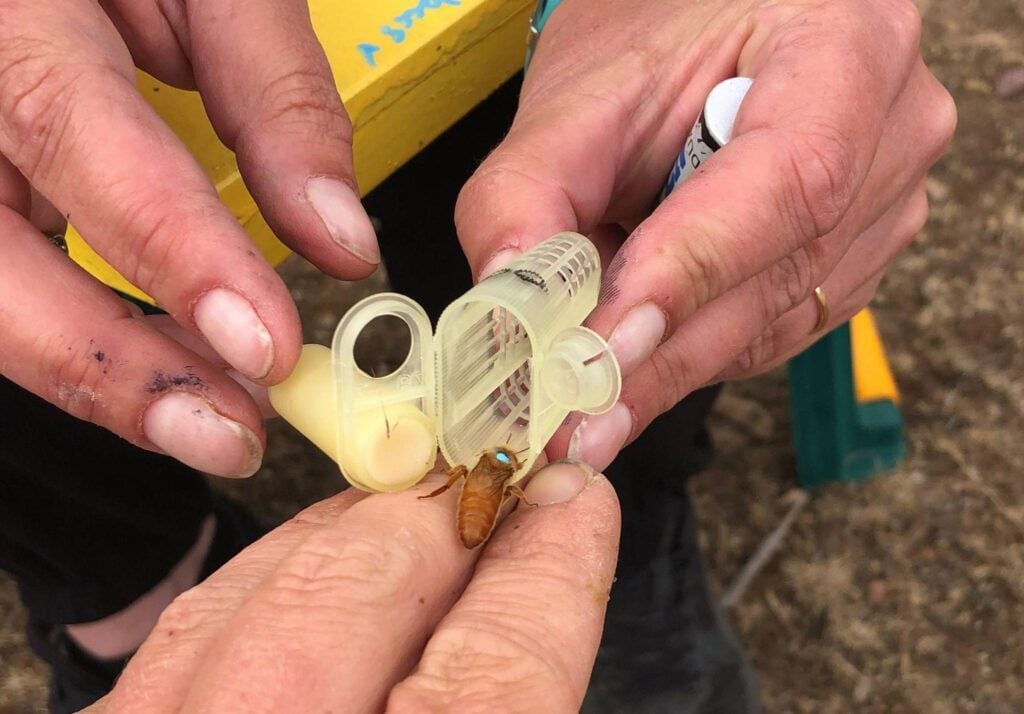Many beekeepers will be wondering how to best manage varroa in their hives. A well equipped Integrated Pest Management (IPM) tool kit will comprise of cultural and chemical measures to be employed based on colony infestation thresholds.
While chemicals are useful in certain situations, such as high mite loads that are a product of natural population growth, or to prevent re-infestation from other colonies in the area, long term varroa control isn’t limited to pesticides. In fact, there are several beekeeping techniques that, if employed regularly, can help keep mite populations below a lethal level. With a bit of practice, these techniques can become a part of a beekeeper’s usual routine.
The mite spends most of its life within brood cells – and it’s in this part of the life cycle that the mites reproduce. Inhibiting brood production for short periods disrupts the varroa reproductive cycle as it denies the mite hosts to reproduce on and results in increased infertility, delayed reproduction, and missing males. While bee numbers can’t grow without brood, by planning a break in the brood cycle, beekeepers can reduce the number of mites in their hives by half.
Queen caging
The simplest and most effective way to initiate a ‘brood break’ is by caging the queen for a brood cycle. The queen can be placed in a cage within the hive, so that she is still cared for by the workers, but cannot lay eggs. Most queens can survive in this way for several weeks, so if the queen is caged for a period of 24 days, the colony will go through a period of broodlessness until she is released and can lay again.

Figure 1. A queen being placed in a cage by beekeepers. Queens can survive for several weeks caged inside a colony. Her inability to lay will induce a period of broodlessness, during which time the Varroa population in the colony will drastically decrease. After 24 days the queen can be released back into the colony, and should resume laying within a few days. (Photo: Jody Gerdts)
The suggested timing of the brood break is for just before a major nectar flow. Without brood to care for, more workers can engage in nectar foraging, so the honey crop is minimally affected by the brood break. Care should be taken to minimize colony impacts post honey flow and avoid doing this on flows known to negatively affect bees. This technique can significantly reduce the mite population within a colony.
Drone brood trapping
Another option is ‘trapping’ mites in drone brood. Varroa mites prefer drone brood. Because drones take longer to develop, the mite can produce more offspring than they do when reproducing on worker brood. Drone and worker brood smell different, and varroa uses these cues to increase their reproductive success.
Beekeepers can remove all drone brood from a colony, then place a single frame of drone foundation so that all drone brood in the colony is in the same place. Many mites in the colony will be attracted to this frame. When it is capped, it can be removed and frozen to kill the mites and infected drone brood. The frame can then be placed back in the hive to repeat the process if necessary.
This method has been shown to lower mite populations by up to 93.4%, and has no adverse effects on the colony.
Splitting the colony
An alternative is to split colonies into queenright and queenless halves. The queenless splits will need time for a new queen to be produced, mate, and commence layings eggs. It takes at least 10 days for the split with the queen to produce brood cells old enough for mite invasion (Gabel et al. 2023). The split without the queen requires 22-30 days for the queen to start laying eggs.
There are a few things to consider with this approach:
- Is the queen good – it might be better to purchase queens rather than letting colonies raise their own
- Do you have enough drones for the queens to mate with? It is worth putting drone comb in your best performing colonies in time to provide drones for your new queens to mate with
Conclusions
As well as losing their ability to reproduce, removing brood also forces all the mites within a colony to leave the combs and attach themselves to adult bees, where they are more likely to be killed by adult bees as they groom each other and also more vulnerable to any miticides that may be being used.
Brood interruption shouldn’t be considered a standalone strategy for controlling varroa. Rather it should be considered as a tool in a well equipped IPM toolbox. By drastically reducing mite populations within a colony, brood interruption can be an effective way to help bolster a colony’s chances of survival after infestation, and will also make any other treatments that may be used much more effective. Monitoring mite populations over time and acting accordingly is the only way to stay ahead of the mite.
More information
Acknowledgements:
- Resilient beekeeping in the face of Varroa. AgriFutures Australia. Holmes, Gerdts, Grassl, Mikeheyev, Roberts, Remnant and Chapman.
- Varroa – Integrated Pest Management. AgriFutures Australia and AHBIC. Holmes, Gerdts, Grassl, Mikeheyev, Roberts, Remnant and Chapman.
- Buchler et al (2020) Summer brood interruption as integrated management strategy for effective Varroa control in Europe. Journal of Apicultural Research 59, 764-773
- Gable et al (2023) Immediate and long-term effects of induced brood interruptions of the reproductive success of Varroa destructor. Apidologie 54: 20
- Jack and Ellis (2021) Integrated pest management control of Varroa destructor (Acari: Varroidae), the most damaging pest of Apis mellifera L. (Hymenoptera: Apidae) colonies. Journal of Insect Science 21: 6
- Lodesani et al (2014) Impact of control strategies for Varroa destructor on colony survival and health in northern and central regions of Italy. Journal of Apicultural Research 53: 155-164
- This article was peer-reviewed by Emily Remnant and Jody Gerdts.

